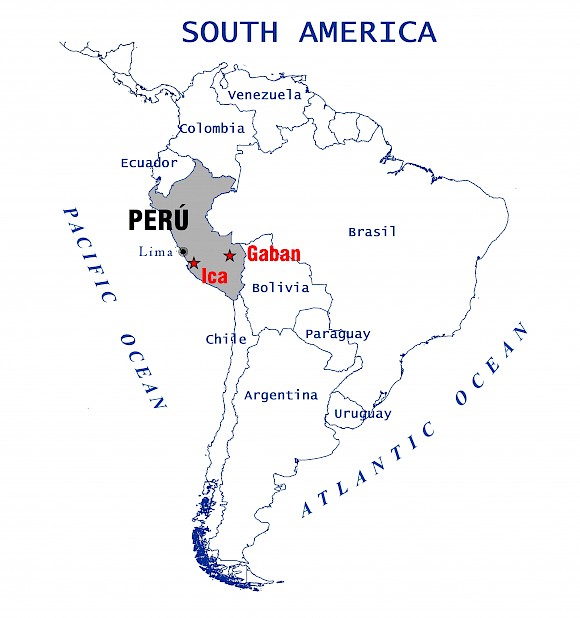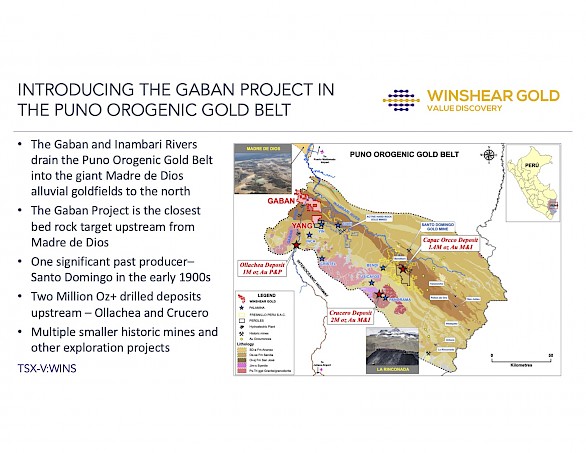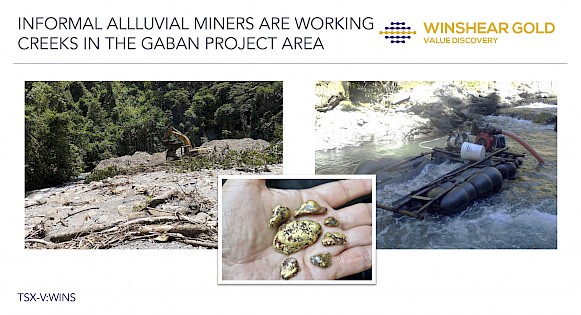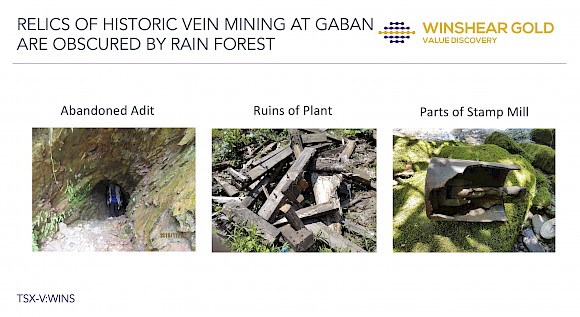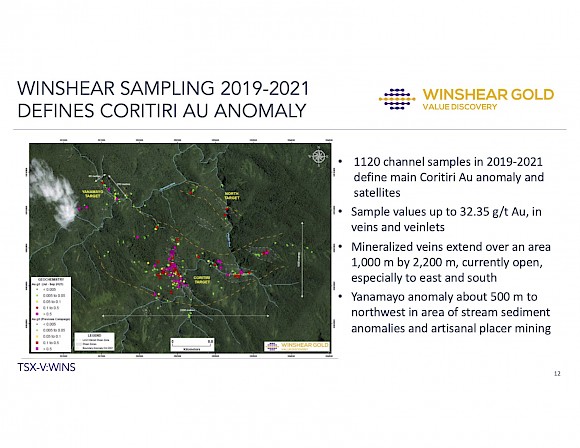Project Summary
| Location: | Along Transoceanic Highway in the Gaban District of southeastern Peru, with abundant hydroelectric power and regional commercial airports within 4 hours drive |
| Concession Area: | 41 concessions totaling 15,629 hectares |
| Ownership: | 100% Winshear, subject to NSR royalty |
| Target Geology: | Puno Orogenic Gold Belt (POGB) on the east side of the Andes - fine-grained sedimentary rocks metamorphosed to low grade, locally carbonaceous, that host auriferous quartz veins and veinlets commonly subparallel to shear zones and foliation |
| Drill Targets: | Field campaigns completed in 2019 - 2021 totaled 1120 bedrock channel samples that define the 2,200 meter by 1000 meter Coritiri gold anomaly and emerging Yanamayo gold anomaly |
| Status: | Permitting a helicopter-supported, 20 drill platform diamond drill program to test auriferous quartz veins throughout the Coritiri anomaly as soon as possible |
Highlights
- See Gaban NI 43-101 Report, project update presentation here and video presentation here.
- Excellent infrastructure: The town of San Gaban lies within the Property limits and serves as a logistical base for exploration teams. The Transoceanic Highway connects San Gaban to major towns including Cusco, Juliaca and Puerto Maldonado within a few hours drive, from where it is possible to fly or drive to Lima. The San Gaban hydro-electric dam has a 206 MW capacity and provides power to the town of San Gaban. (Figure 1).
The principal lithological, structural, and mineralogical controls required for economic orogenic gold mineralization to occur are present in the Puno Orogenic Gold Belt in general, and on the concessions in particular.
Alluvial gold is being recovered by artisinal miners on the concessions, and the concessions are believed to be a source of gold for the giant Madre de Dios alluvial goldfields some 50 km downstream in the Amazon basin along the Gaban and Yanamayo Rivers. (Figure 2)
Historic bedrock mining occurred on the concessions, evidenced by adits and remains of a mill building and stamp mill (Figure 3)
Auriferous quartz +/- sulfide veins are distributed over the Coritiri anomaly, measuring some 2200 m by 1000 m and open particularly to the east (Figure 4).
Broadly similar geology to the Ollachea deposit (1 million ounces reserve owned by Minera IRL at feasibility stage) located 40 km south of Gaban and to the Crucero deposit (2 million ounce resource owned by Gold Mining) located about 150 km to the southeast (Figure 1).
Background
In September 2019, Winshear acquired a 100% interest, subject to a 2% NSR, in the Gaban and Yang Gold Projects and Ica IOCG Project in Peru from Palamina Corp through the issuance of 10,000,000 common shares of Winshear (see news release here).
2024 1,600m maiden drill program
On June 18, 2024, Winshear announced it has initiated field activities at the Gaban Gold Project, SE Peru, including construction of an access road to the Coritiri Gold Zone, a staging field camp and the preparation of five drill sites in anticipation of a 1,600m helicopter supported diamond drill program.
Work done by previous owner
Palamina completed an initial aeromagnetic survey and acquired the concessions in 2018. They conducted geological mapping, stream sediment sampling (80 samples), and rock sampling (183 samples) that defined the Coritiri target of coinciding aeromagnetic, stream sediment, and bedrock auriferous gold veins.
Winshear work at Gaban in 2019 through 2021
Multiple field programs conducted by Winshear Gold through the end of 2021 have focused on confirming and enlarging the Coritiri stream sediment and bedrock gold anomaly (Figure 4).
- A total of 1120 channel samples taken in 2019-2021 define the Coritiri Au anomaly and emerging Yanamayo anomaly
- Sample values up to 15.8 g/t Au, in veins and veinlets.
- Mineralized veins extend over an area 900 m by 2,000 m, currently open, especially to the east.
- Highlights include 32.35 5g/t Au over 1m, 5.72g/t Au over 1.5m, 3.57g/t Au over 2.5m, and 5.7g/t Au over 1m.
- The mineralized area correlates strongly with an east-southeast trending geophysical target that is open to the east southeast and west northwest.
- Samples were collected from sheared sedimentary rocks, typically siltstones and shales / slates, with varying amounts of quartz veining and carbonaceous material.
- The sedimentary rocks are identified as belonging to the Ordovician San Jose Group.
- Quartz veins vary in thickness from 1mm up to 80cm in width.
- As much as 3% sulphides (pyrite and arsenopyrite) are associated with the quartz veins.
Results first field campaign completed in October 2019
Winshear conducted exploration to locate the hard-rock source of alluvial gold in the Yanamayo and Piquitiri rivers, which drain into the Madre de Dios basin. In 2018, a heli-borne geophysical survey was flown over Gaban as part of a systematic exploration program that outlined regional structures with the potential to host gold mineralization. To date five shear zones have been identified on the property. The goal of the 2019 field campaigns was to identify the most prospective sections of these newly identified structures. A second campaign was conducted in November / December 2019 and will be reported as results are received.
Key Points:
- First field program conducted by Winshear Gold focused on the Coritiri stream sediment anomaly.
- 81 channel samples of bedrock (1.0-2.5m in length) were collected;
- 17 samples returned 0.1g/t – 0.49 g/t Au
- 6 samples returned 0.5 g/t – 0.99 g/t Au
- 7 samples returned 1.0 g/t – 4.99 g/t Au
- 2 samples returned 5.0 g/t – 9.99 g/t Au
- 1 sample assayed 15.75 g/t Au
- Highlights include 15.75g/t Au over 1m, 5.72g/t Au over 1.5m, 3.57g/t Au over 2.5m, and 5.7g/t Au over 1m.
- The mineralized area correlates strongly with an east-southeast trending geophysical target that is open to the east southeast and west northwest.
- Samples were collected from sheared sedimentary rocks, typically siltstones and shales / slates, with varying amounts of quartz veining. The sediments are identified as belonging to the Ordovician San Jose Group. Quartz veins vary in thickness from 1mm up to 80cm in width.
- Up to 3% sulphides (pyrite and arsenopyrite) are associated with the quartz veins
- The geology in the target area correlates well with other known deposits in the POGB including the Ollachea Project 40 km to the SW.
- Numerous old prospect adits were discovered in the area, some of which were up to 15m long.
Figure 1—Location of the Gaban project in the Puno Orogenic Gold Belt of southeastern Peru
Figure 2—Alluvial gold is the focus of current artisanal mining on the concessions
Figure 3 - Relics of historic underground vein mining and processing on the Gaban concession
Figure 4 - Winshear bedrock sampling as of December 31, 2020 and the resulting 2000 m by 900 m Coritiri gold anomaly

